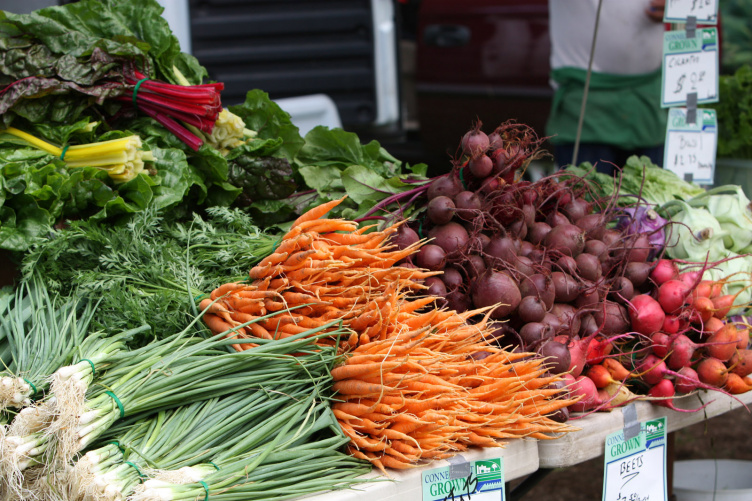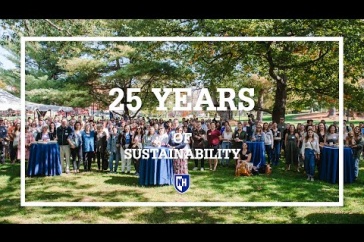
In a large meeting room at Housatonic Community College in Bridgeport, Connecticut, nearly 200 people had gathered to talk about one of the most basic needs, and yet most complicated topics emerging today: food.
There were farmers in jeans and flannel shirts, young and old, dirt caked into their nailbeds, and faces browned by the long sunlight they work under in rows of corn or Brussels sprouts or organic carrots. They chatted alongside politicians in crisp business suits who, like the rest of the attendees, want to provide jobs and improve the health of the underrepresented people in their communities, researchers who combine field work with theory to imagine a better food system for the Northeast and social organizers and community leaders, representing those work in fields, fisheries and grocery stores and those who experience food insecurity on a regular basis.
It was an eclectic group that had gathered in early June for the 6th annual New England Food Summit, but it represents of exactly the kind of collective approach it will take to change the way we’re growing, consuming and thinking about food in New England, say organizers from Food Solutions New England, a regional network coordinated by the Sustainability Institute at UNH.
Food Solutions New England (FSNE) works to strengthen the regional food system. For the last three years, FSNE has been shepherding research to create A New England Food Vision. Nicknamed the “50 by 60” idea, it calls for a healthy, sustainable food system for all, by which the region produces 50 percent of its food supply, through sustainable farming and fishing, by the year 2060. Currently, New Hampshire produces just 10 percent of the food that its residents consume.
“We cannot get there by working separately. This is a kind of work that is deeply engaged in a collaborative process. What we’re doing doesn’t look like traditional or conventional research. That’s what makes it so challenging and so fascinating,” says Tom Kelly, chief sustainability officer and founding executive director of the Sustainability Institute.
FSNE, founded in 2011, is on the forefront of a growing regional and national conversation about not just what we eat, but where it comes from, and who has access to it. National discussions on food insecurity, racial and ethnic biases in the distribution of our country’s food supply, and social justice issues of food-chain workers are now mainstream in today’s world.
Want to Know More?
Read how Food Solutions New England and the New England Food Vision are reaching farmers, lawmakers, food network workers and residents throughout the region here.
Why is a regional food system so vital? In simple terms, a regional food system means that your food is from source nearby, and is fresher and therefore healthier for you. But it’s more than that. Consider the growing concerns about the use of chemicals, pesticides and preservatives in our food system, contamination scares brought on by mass-produced food, and the negative environmental impact of importing foods from thousands of miles away, and most people now believe “EAT LOCAL” is more than a bumper sticker slogan, it’s an idea we must embrace collectively.
Currently, roughly 90 percent of the food we eat in New England comes from outside the region, according to FSNE. Its New England Food Vision illustrates how that means we are part of the global industrial food system that produces enough food, but does not ensure equal accessibility. Despite the abundance of food, as many as 10 to 15 percent of New England households regularly do not have enough to eat.
The work and discussions that took place during The Food Summit in June were one example of the cooperative style that FSNE champions throughout the year. At the two-day event, collectively and in smaller groups, participants reviewed case studies, shared personal experiences and discussed policies. Ten different breakout sessions were held on topics ranging from food waste and recovery, environmental nutrition and institutional procurement of local food, to worker justice and food policy.
Kelly says FSNE is unique in that many of the donors — both individuals and representatives from foundations — not only provide funding to the organization, but they also roll up their sleeves and participate, because they are also working in the food systems on similar challenges.
“That’s part of a new paradigm in philanthropy, and not all foundations or donors can take part in their causes. It’s a great way to work, because it’s all about collaboration; you end up in configurations of people from public universities like us, private foundations, nonprofits, government agencies, the private sector. It’s a wonderful mix of people coming together,” says Kelly.
Donors such as the John Merck Fund and the Henry P. Kendall Foundation are prime illustrations of active partnerships.
When the Kendall Foundation turned its attention to the New England food system five years ago, says Kendall’s senior program advisor Courtney Bourns, leadership knew there needed to be a long-term strategic action plan in order for Kendall to launch a grant-making program that would be able to support change in the regional food systems. Bourns says the foundation was happy at that time to learn about Food Solutions New England’s 50 by 60 vision, and their work in this area.
“We realized pretty quickly that we wanted to tie our wagon to the 50 by 60 vision and Food Solutions’ bigger regional picture. It became a rally point for our own strategy,” Bourns explains. “We thought, ‘If there is a growing alignment around the regional vision, how can we help promote that and tie own strategy to it?’ It helped shape our philanthropic role around food systems work.”
Bourns said the 2016 Food Summit, which she attended, was a great example of the reasons Kendall supports FSNE.
“Since I first met Tom Kelly, it’s apparent that he and his team really believes in that need for a network that connects people who can collaborate in big and small ways to make that vision come to life,” says Bourn. “The real strength of FSNE is knitting together that connection across the region, and keeping that thread of conversation alive about the vision.”
Kelly notes that donor support and connection are both “absolutely critical” to FSNE’s work, because donors enable FSNE to create the perfect conditions for such alliances to be built. “Because of that support, we can bring diverse people together and allow them to create an agenda and to increase their ability to shift the system toward sustainability.”
Beyond the annual summits, the organization recently launched a Network Leadership Institute, The first, which was held over three days in late September, included 18 people from all six states. Another is planned for November, and another day-long session will be held in January. The objective is to provide its participants with a chance to develop a greater understanding of how FSNE can help them in their work in our regional food system, and also provide networking opportunities.
For Kelly, this work draws directly from UNH’s roots as a public land grant university.
“Everyone intuitively recognizes that we have to work collaboratively across these sectors and points of view, and we work to create conditions that favor that, and facilitate that. I think that’s part of what excites our donors, and I know that’s what inspires me and my colleagues.”
Bourns agrees.
“More and more, all the people in the food system recognize this mutual need of one another. I think businesses recognize they need to be in shared conversations with consumers and with other producers. They are realizing that it can be really beneficial to be talking to the compositing companies, to the fisheries and the farmers where their product comes from.” In order to improve the food system regionally, she says, “People realize we need to be in a shared conversation about the bigger food system. Everyone’s getting the idea.”
-
Written By:
Michelle Morrissey ’97 | UNH Magazine | michelle.morrissey@unh.edu



















































